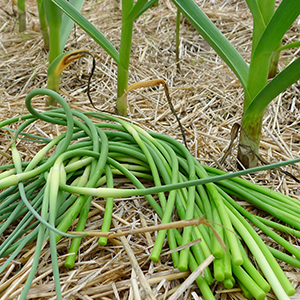
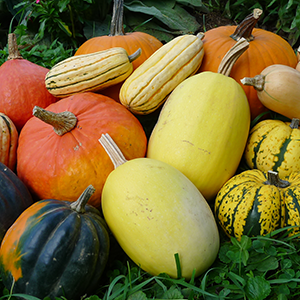
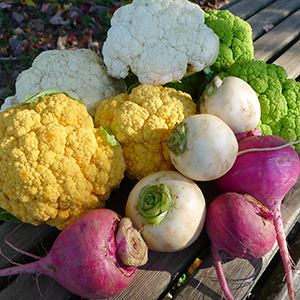

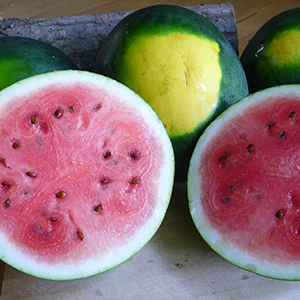
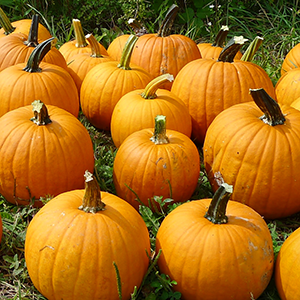
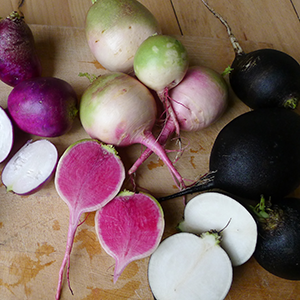



News and Notes | The Anchor Run Blog
Posts Filtered by Month - November 2016 |
Show Recent Posts
November 27, 2016
An End of November Harvest
By Derek McGeehan
An End of November Harvest
By Derek McGeehan
Late Fall Harvest #3 (Week A) should include radicchio, head lettuce, lettuce mix, kohlrabi, sweet potatoes, potatoes, garlic, fennel, radishes, celeriac, kale, collards, spinach, arugula, and greens mix. Some items may be a choice.
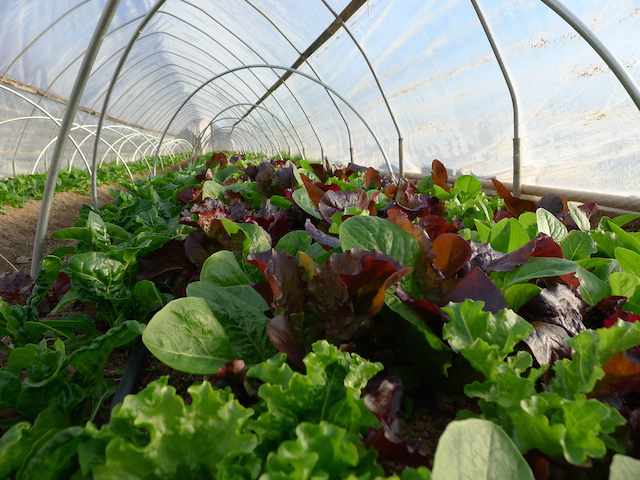
Under protection of the hoop house the lettuce mix is now ready for harvest.
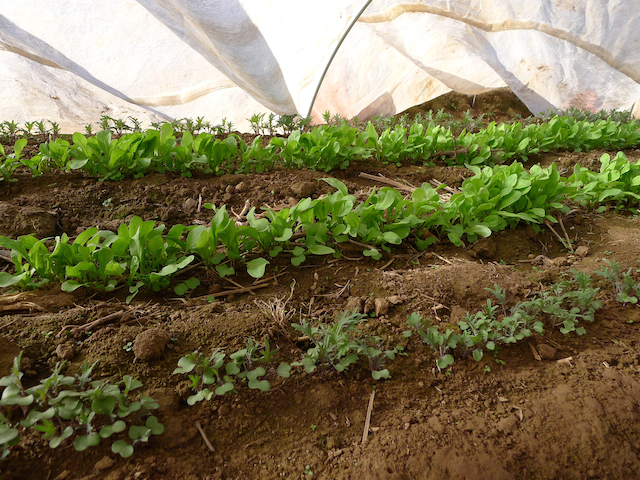
A very late seeding of red russian kale and arugula continues to grow under low hoops and heavy row cover.

November 27, 2016
A Continued Green Autumn
By Derek McGeehan
A Continued Green Autumn
By Derek McGeehan
December commences this week as we move slowly towards the end of the calendar year. I believe some folks refer to December as the beginning of meteorological winter. Another few weeks of lessening daylight, then with official start of astronomical winter on December 21st daylight will begin to slowly lengthen. It probably won't feel like winter until January. The winter winds were working their way around last week, though, removing whatever warmth hung around with the prior week's minor heat wave and also quickly dismantled whatever leaves hung around so that now it looks like winter. There are a few move leaves clinging desperately to the large trees surrounding our house and I'm hoping they've finished their gravitationally induced fall before I attempt to clean our gutters prior to the forecast significant rainfall midweek, the first in a very long time. It has been a mostly lovely autumn and I'm glad for the return of some sustained sunshine today. Outside crops are still thriving, though a few of the more cold sensitive ones show a bit of stress from the wind and the subsequent drop into the mid-20s last week.
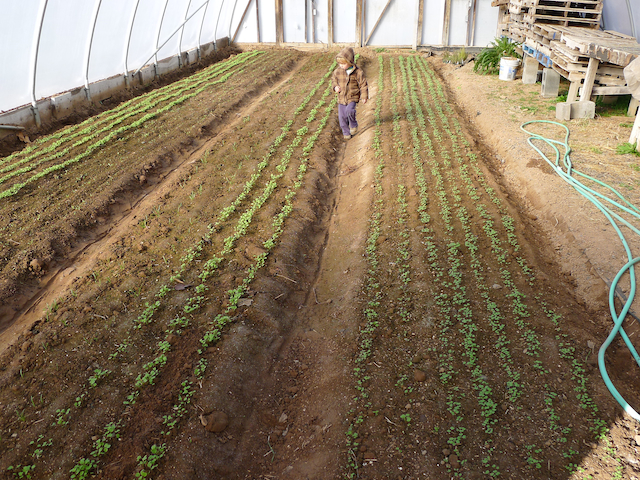
Gabriel inspects raised beds of winter greens inside the greenhouse.
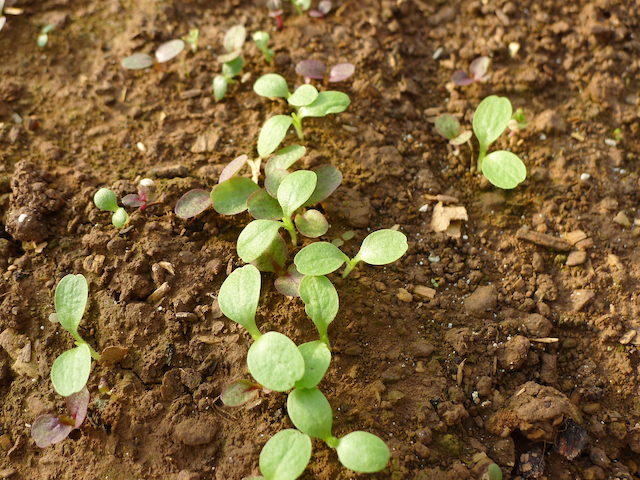
Baby lettuce mix seedlings slowly beginning their life above the soil.

November 20, 2016
Vegetables Riding the Temperature Roller Coaster
By Derek McGeehan
Vegetables Riding the Temperature Roller Coaster
By Derek McGeehan
Late Fall Harvest #2 (Week B) should/could include spinach, lettuces, radicchio, cauliflower, fennel, onions, potatoes, herbs, kale, collards, yukina/tatsoi, and miscellaneous roots. Some items will be a choice.
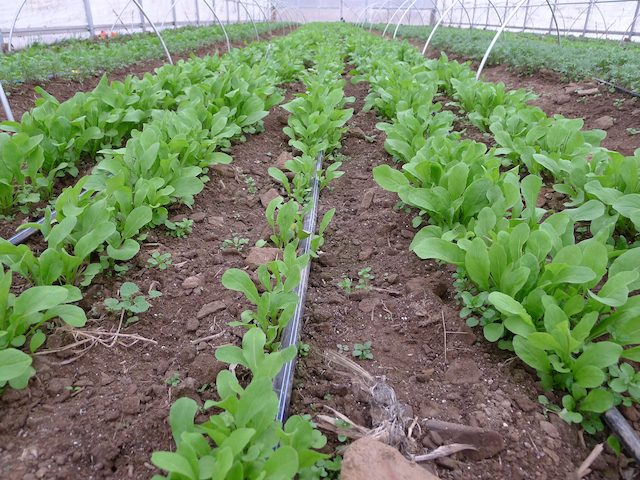
Cold-hardy arugula, growing fast in the almost 70-degree heat. Hoops are already in place for an eventual added cover.

November 20, 2016
Blowing in the Wind
By Derek McGeehan
Blowing in the Wind
By Derek McGeehan
I love this time of year (most of the time, when the weather is good, and crops are healthy). The amount and pace of work is manageable, and with one main pick up day per week with approximately 30% of the Main Season membership, harvesting is much easier. Besides continuing the growing season and protecting crops, we reflect on the successes and failures that occurred over the past 9 months and begin to think about possible improvements. Our thoughts begin to meander towards the 2017 growing season, what new crops to try, what perennial plantings to invest in, what crops to quit growing, how to improve members' CSA experience. I love the time and space relationship between planning and planting for future harvests. Investing in an additional 40 fruit trees, 300 raspberry bushes, and 3000 strawberry plants requires a vision of the future. Where will the crops go? What's the soil like? When will harvests begin? What will pest pressure be like? If it's a u-pick crop, can it be grown near the central area? Is it worth the investment? It's quite easy to dream and be hopeful this time of year, especially after a satisfying and successful growing season. We feel safe.
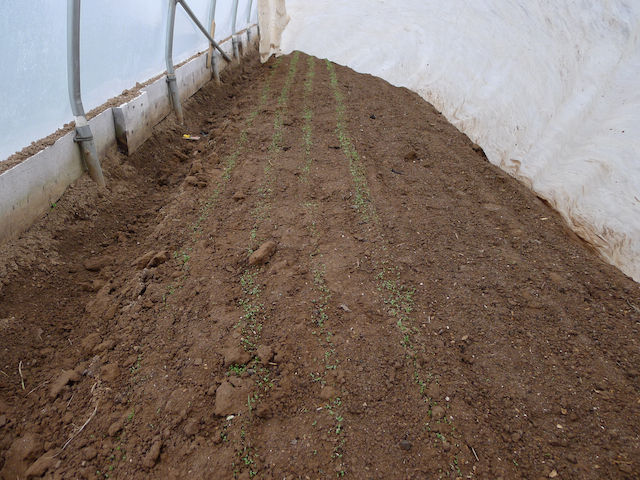
Very, very young lettuce mix under triple protection in the optionally heated greenhouse for January and February harvests.
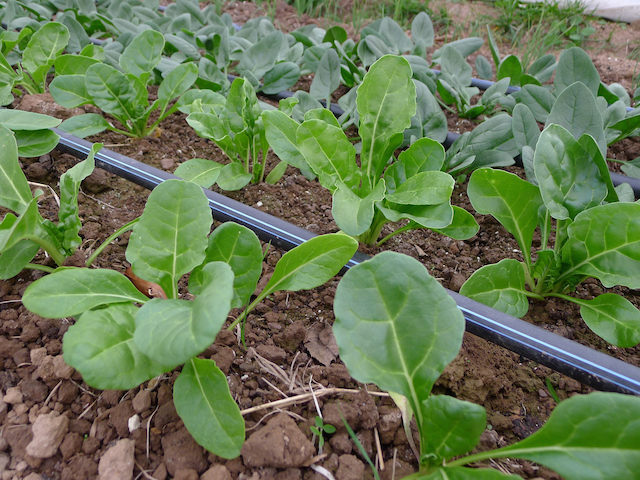
Under protection in the unheated hoop house, chard and spinach look healthy and happy.

November 20, 2016
Extreme temperatures
By Linda Dansbury
Extreme temperatures
By Linda Dansbury
The crazy temperatures make it somewhat of a challenge in planning meals: for a few days windows are wide open and it is ideal for grilling. Now, a dramatic and sudden change to windy, cool weather will drive us back to the oven. I did make a few delicious dishes this week:
Leek, onion, garlic, a lot of greens - made a soup called Sausage and Greens soup. There are a lot of versions on the internet but the one I made is in the Simply in Season cookbook. I sauteed up some sausage(Ledemete Grass), then added chopped leeks and onions and then the garlic and let them all get soft. Added chicken stock(you can use veggie stock too) and then a lot of slivered up greens. Then added some evaporated milk - I haven't done this before, but a friend told me about this recipe.
Beets, onion, carrot, potato, cabbage, kale, dill, parsley - again, using the Simply in Season cookbook, I made the Winter Borscht recipe that was in there. If I made it again, and I probably will, I will use a stock rather than the water it calls for - other than that, it was a great way to incorporate a lot of our wonderful harvests!
Cauliflower, sweet potato, onion, garlic, rosemary - roasted in the oven until all were soft and browned - YUM!

November 20, 2016
A Note on Cauliflower
By Linda Dansbury
A Note on Cauliflower
By Linda Dansbury
If you find you have a lot of cauliflower, and are not sure what to do with it, consider how many options you have: raw as a snack, steamed or boiled till desired tenderness, made into a soup, boiled until soft and then mash it as you would potatoes, and roasted. Here is an easy way to roast your caulifower for a delicious side dish:
Heat oven to 400 degrees. Slice or cut cauliflower into pieces larger than bite sized - the more surface area you have on the sheet pan, the better. Slice a garlic clove or 2 and toss it along with the cauliflower in some olive oil - salt and pepper and thyme if desired. Roast, turning occassionly until not quite tender. Take out of the oven and sprinkle with some grated parmesan cheese. Return to the oven until cauliflower is tender and cheese is melted. Enjoy!
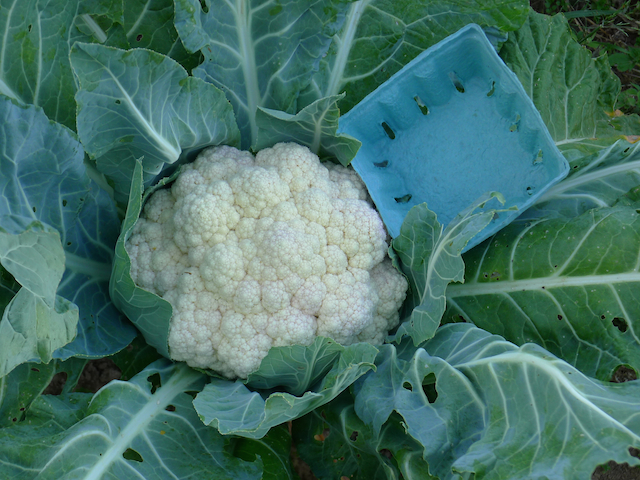
Hey, that's a nice head of cauliflower (next to a quart container for perspective).

November 13, 2016
Super food - Super Moon
By Linda Dansbury
Super food - Super Moon
By Linda Dansbury
This week we had beautiful fall weather and the moon the past couple of evenings has been so pretty - tonight at sunset begins the arrival of the Super Moon - a full moon that appears larger and brighter than normal because the moon is closer to the Earth. We won't see a moon like this again until 2034, so get outside tonight and enjoy the show!
Here are a few yummy things I made this past week.
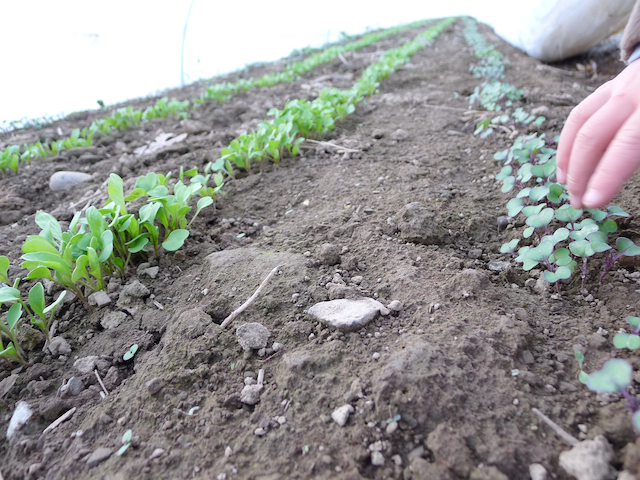
Baby arugula and baby kale and a baby hand.
Kale, onions, garlic, cilantro, Ledemete Grass ground pork - made a delicious and healthy soup roughly using a recipe from Eatingwell.com. The recipe called for using a pork tenderloin but I used the ground pork instead. It also incorporated a can of white beans and we also added a can of black beans and used a lot of the beautiful cilantro from the farm. Simple to make and it provided 2 nights of delicious, healthy dinner.
Potatoes, sweet potatoes, celeriac - made a "mixed mash" - my term for a delicious variation - if you haven't already tried it, you should - you and your family won't be sorry.
Spaghetti squash, parsley - we received this delicious parsley so I incorporated a good amount of it in this dish - cut the squash in half and dug out seeds and membranes. Drizzled a little olive oil and salt and pepper and baked cut side down until cooked through. Meanwhile, in a large bowl, mixed together some ricotta cheese, chopped toasted hazelnuts(some other nut would work, but this was delicious), toasted breadcrumbs and a healthy amount of chopped parsley. When squash was finished, "forked" the squash strands and put them in the bowl and mixed everything together. Drizzled a bit of good olive oil over the top. It was delicious. Sadly, this was the last of my spaghetti squash from the farm.
If you would like to share something you are making with the rest of the membership, please email me at lindadansbury@comcast.net and please put Anchor Run in the subject line.

November 13, 2016
Late Fall Harvest #1 (Week A)
By Derek McGeehan
Late Fall Harvest #1 (Week A)
By Derek McGeehan
Late Fall Harvest #1 (Week A) could include kale, lettuce, fennel, cauliflower, potatoes, onions, herbs, baby kale, yukina savoy (asian green like tatsoi), mizuna, radicchio, greens mix, and miscellaneous roots.
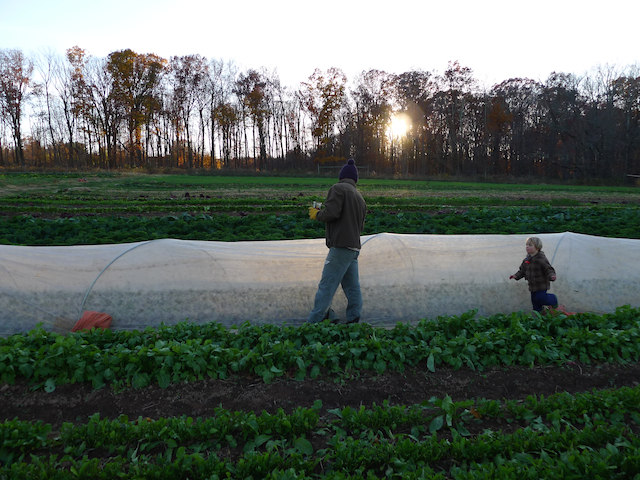
Checking on scallion-protecting row cover after a windy night.

November 13, 2016
5th Annual Late Fall CSA Begins
By Derek McGeehan
5th Annual Late Fall CSA Begins
By Derek McGeehan
Technically a new CSA season but really an extension of the continued growing season, the 2016 Late Fall CSA begins this Wednesday 1-8pm for Full Shares and Week A Half Shares. Week B Half Shares start next Tuesday, November 22nd, 1-8pm. Wednesday is the main pick up day, but there is also a Saturday 11am-12noon option for those of you with busy weekdays. You must e-mail us to choose the Saturday option permanently, or to request a temporary switch. If you're a Late Fall Half Share owner, log in here to find out what week of pick up you are. If you were a half share owner during the main season your pick up week is the same unless you requested a different week for this current season.
We're very much looking forward to and excited about the continued harvests. Cold hardy crops thrive this time of year. Greens only get sweeter after a touch of frost and a freeze. This fall so far has been particularly kind to us; we've had numerous widespread heavy frosts but no deep freezes yet. In fact, the temperature has only bottomed out in the upper 20s a few times. Even the least cold-hardy unprotected greens like head lettuces aren't showing damage yet. Either way, we took necessary steps to cover a good portion of the crops for the continued growing season, assuming eventually they'll need the added protection. After it gets truly cold, perhaps not until January, we'll begin harvesting from the larger protective structures. See the bottom picture below for the various cold protective strategies.
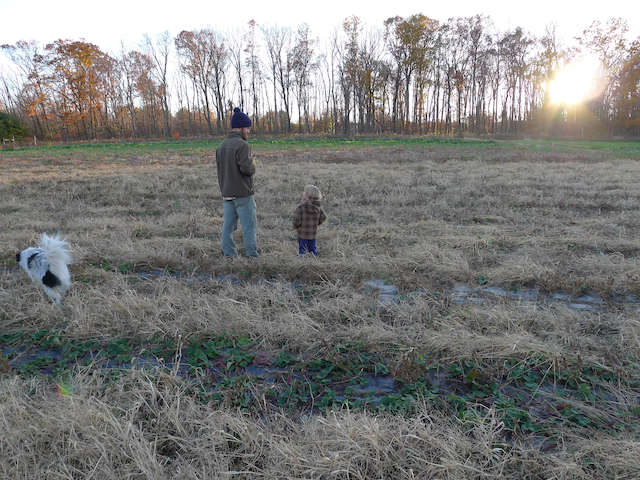
After a very rough beginning during an extremely wet (and hot) July followed by an extremely dry (and hot) August, our 2017 strawberry patch plants seem to have pulled through successfully (they're in green in the foreground).
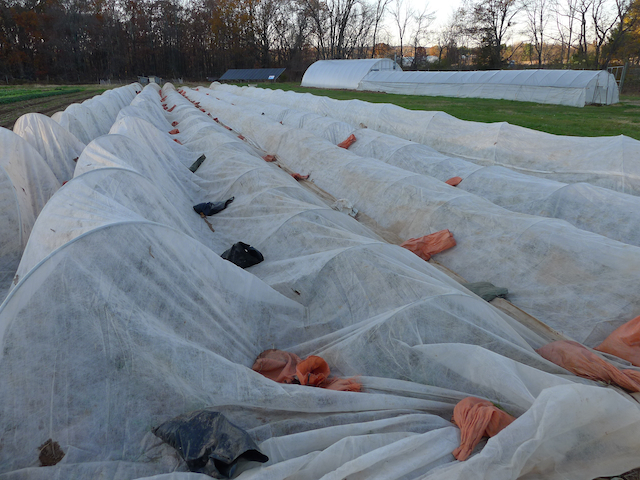
Low hoops made from bent 10-foot 1/2-inch electrical conduit plus even lower hoops made from heavy gauge wire covered with fabric and anchored with sandbags will hopefully protect scallions, lettuces, yukina savory, chard, spinach, kale, and arugula for another month or two. In the background the greenhouse and hoop house protect additional crops for winter harvests.

November 6, 2016
Endive, Escarole, Radicchio - AKA Chicory
By Linda Dansbury
Endive, Escarole, Radicchio - AKA Chicory
By Linda Dansbury
While in the pick up room this past week, we had a discussion about endive, which was beautifully sitting in its bin, waiting to be picked up. A member asked how to use it because she finds it just too bitter to eat. Derek and I both starting waxing poetic about how much we love this green - he puts 2 heads into his and Dana's smoothies each day - the smoothie mixture overcomes the bitterness and it is delicious - he also said it is a great liver detoxifier - sounds like a great reason to gobble it up just for that!
Both endive and escarole are bitter when eaten raw, on their own. But both are equally happy when mixed with other things and/or when cooked, which makes them much milder tasting.
My German grandmother used to make endive salads - she would soak the endive in warm water to remove some of the bitterness. She would make a dressing of lemon juice, a mild oil, celery salt and pepper - and she would sprinkle some fresh chopped parsley over the top. It was especially delicious with rich foods, such as beef stew - or turkey!
Escarole, endive's close cousin, is what was traditionally used in Italian Wedding Soup - growing up, my Italian grandmother called it Escarole Soup.
Both endive and escarole can be cooked in a pan with olive oil, garlic and a sliced hot pepper (from your freezer, remember?) or red pepper flakes, like many of you have done with many of the other greens. Or, add them to your soups and stews for added nutrients and color.
Embrace these 2 versatile, nutritious greens!
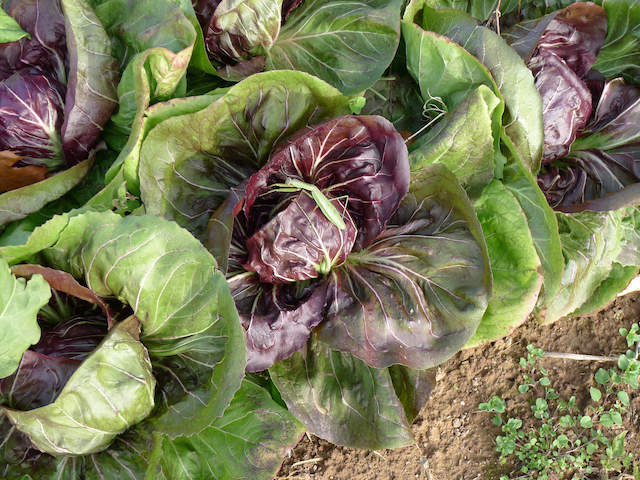
Not too bitter for this praying mantis, radicchio is a truly appealing vegetable.

November 6, 2016
Salads and Stews
By Linda Dansbury
Salads and Stews
By Linda Dansbury
This week I used the pressure cooker again to make dishes that we could get at least a couple of meals out of. It makes meals for the week nights easier, faster, and delicious!
Local pork, onions, garlic, tomatoes I had frozen, a hot pepper from freezer, greens - pressure-cooked this concoction - it came out tender and delicious - once the pressure was down, and I opened the cooker, I added chopped greens and just let them wilt. All we had to do was make pasta to go with it. Topped with a lot of the delicious cilantro we have been receiving.
Local lamb shanks - basically did the same thing, only this one had dried porcini mushrooms and no hot peppers so the taste was very different even though the process was virtually the same- topped with parsley.
Beets - come to think of it, I could have put these into the pressure cooker too, but I roasted all that I had, peeled and sliced them and tossed them in a nice vinaigrette because they will keep for quite awhile this way. I made a few salads incorporating a few different greens, the beets and various toppings that are seasonal - apples, pears, goat and feta cheese and nuts. Salads such as this with beets, which are a bit sweet, work really well with some endive or escarole.
Squash, herbs, garlic - made a stuff winter squash recipe that was literally a "stuffing" - day old bread, garlic, onion component, several herbs, cheese and milk to hold it together. Then it was baked for a long time - it was delicious!

November 6, 2016
Final Main Season Share
By Derek McGeehan
Final Main Season Share
By Derek McGeehan
Main Season Harvest #26 (Week B) should include lettuce, kale, potatoes, fennel, cauliflower, chives, parsley, onions, bok choy, arugula, spinach, greens mix, escarole, endive, radicchio, and miscellaneous roots. Some items will be a choice and may not be available during all pick up times.
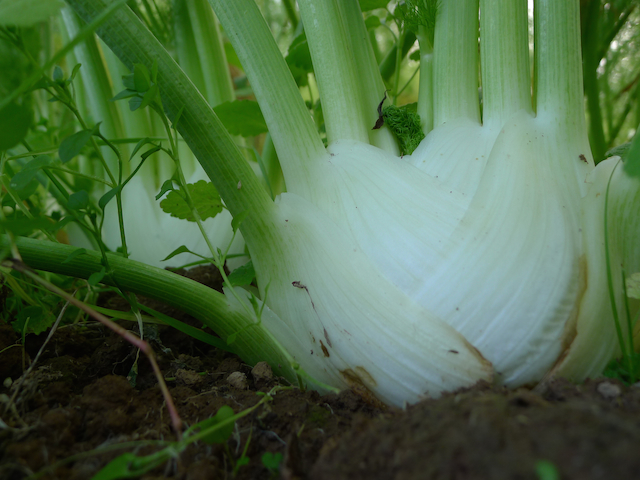
The fennel bulb at home under its own canopy

November 6, 2016
Workshifts For Week of 11/6 - GARLIC!
By Derek McGeehan
Workshifts For Week of 11/6 - GARLIC!
By Derek McGeehan
It's garlic planting and mulching time! This is the final crop we'll be planting outside this year, and we won't harvest it until July 2017. Three hundred pounds of cloves will be planted 6 inches apart in 3 rows over eleven 180-foot beds. How many cloves is that? 11,880. After we plant the garlic we'll mulch it with straw to protect and insulate the soil over the winter months and smother weeds come spring and summer.
Workshift sign-up instructions may be found here.
Shifts:
Tuesday 11/8 9:15-11:15am & 1-3pm
Wednesday 11/9 10am-12noon & 1-3pm

November 6, 2016
Sign Up Now For Extended CSA Seasons!
By Derek McGeehan
Sign Up Now For Extended CSA Seasons!
By Derek McGeehan
It's time to sign up for our 5th annual Late Fall CSA as well as our inaugural Winter CSA to receive your supply of fresh, local, and organic produce through the dark winter months!
Enrollment in these seasons is limited and will be filled on a first-come first-serve basis.
To participate in these seasons, please Log in to the website and click the green 'Join' buttons on the left hand side of your member page.
2016 Late Fall CSA:- 6 weeks of fresh and storage crops from weeks 11/13/16 through 12/18/16
- weekly full shares ($180) and biweekly half shares ($100) available
- share distribution on Wednesdays 1-8pm (except for Tuesday 11/22/16) and Saturdays 11am-12noon
- should include a variety of crops like beets, potatoes, radishes, turnips, sweet potatoes, leeks, garlic, scallions, lettuce, radicchio, cabbage, napa cabbage, arugula, mizuna, mustard greens, kale, collards, chard, spinach, herbs, etc.
- 8 weeks of fresh and storage crops from weeks 1/1/17 through 2/19/17
- weekly full shares ($240) and biweekly half shares ($130) available
- share distribution on Wednesdays 1-8pm and Saturdays 11am-12noon
- should include a variety of crops like beets, potatoes, radishes, turnips, sweet potatoes, leeks, garlic, scallions, lettuce, cabbage, napa cabbage, arugula, mizuna, mustard greens, kale, collards, chard, spinach, herbs, etc.
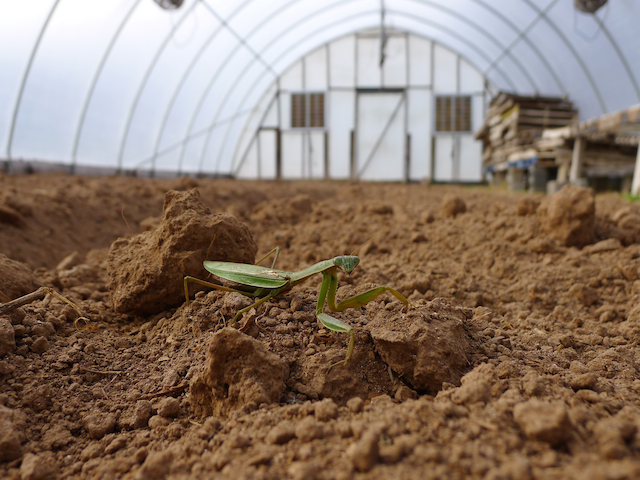
Found inside our optionally heated greenhouse, this praying mantis is welcoming you to participate in the extended CSA seasons.

November 6, 2016
With Heartfelt Thanks
By Derek McGeehan
With Heartfelt Thanks
By Derek McGeehan
So, we're at the end of the 2016 Main Season CSA already. It surely flew by. It feels like a successful season and we're thankful for all of our members/friends/neighbors that participated, supported, and helped along the way. We're also very thankful (and lucky and fortunate) to have had a great, hardworking, enthusiastic, intelligent, diligent, knowledgable farm crew this year. Hannah and Mary Liz were here for the full length of the season, Mark was here for the summer months. They were an indispensable component of the farm's success this year. Hannah is returning for another season on the farm; Mary Liz is moving to the Boston area and will pursue work on another organic CSA farm.
We hope as an Anchor Run CSA member you feel satisfied with your experience this year and will return for future seasons. Stay connected - to the farm, to your farmers, to the soil and the food that is grown here. As of now you can sign up for the 2016 Late Fall CSA, the 2017 Winter CSA, and the 2017 Main Season CSA here. Thank you, and have a good great offseason!
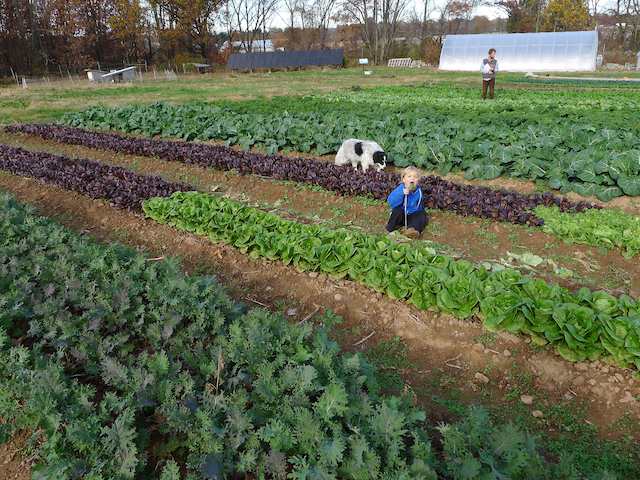
Checking out the Late Fall and Winter crops, planning harvests, sampling along the way, reconnecting after being away for a couple of days.

POSTS BY TYPE
POSTS BY MONTH

